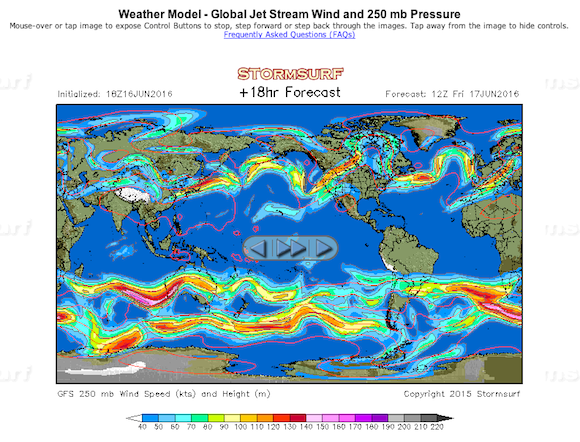It looks like you're using an Ad Blocker.
Please white-list or disable AboveTopSecret.com in your ad-blocking tool.
Thank you.
Some features of ATS will be disabled while you continue to use an ad-blocker.
share:
a reply to: zworld
Nature, has always eliminated any species that ends up causing its own demise, all by itself.
The japanese people have decided that they will continue to occupy a small island chain that is, and will continue to be, contaminated with radiation that, will end up wiping out that island. It's a matter of time. They can keep moving the dangerous materials around, but to quote a line from "Pure Country" : "you know that white spot, right there on the top of chicken sh!T? Yeah, that's chicken sh!t too".
This radiation is going to far outlast the Japanese people. The entire island chain will end up being banned from occupation for as long as the human species occupies this planet.
Sorry, engineer, I think things through to the logical conclusion.
We need to start barricading the island chain, but especially the area around fuk, and right now. If we don't, this entire planet will become so contaminated that nothing other than cockroaches will be able to live here for millions of years.
Nature, has always eliminated any species that ends up causing its own demise, all by itself.
The japanese people have decided that they will continue to occupy a small island chain that is, and will continue to be, contaminated with radiation that, will end up wiping out that island. It's a matter of time. They can keep moving the dangerous materials around, but to quote a line from "Pure Country" : "you know that white spot, right there on the top of chicken sh!T? Yeah, that's chicken sh!t too".
This radiation is going to far outlast the Japanese people. The entire island chain will end up being banned from occupation for as long as the human species occupies this planet.
Sorry, engineer, I think things through to the logical conclusion.
We need to start barricading the island chain, but especially the area around fuk, and right now. If we don't, this entire planet will become so contaminated that nothing other than cockroaches will be able to live here for millions of years.
it seems so strange to me that the Japanese are aiding in their own demise by spreading this stuff all around.
building roads with it you say?
building roads with it you say?
a reply to: autopat51
Absolutely insane. I remember reading that finding a safe way to dispose of the radioactive waste was paramount for the Olympics. To think that they would take something that they know is toxic and dangerous, remove it from where it is, and then use it for roads and levees all over Japan is beyond beyond to me. Do they really think that people from around the world are going to come to Japan for the Olympics knowing that the roads they may be driving on are radioactive.
When I first read the headline for the story I thought for sure there was a twist. There had to be a twist. But it doesnt look like there is one.
Totally insane.
Absolutely insane. I remember reading that finding a safe way to dispose of the radioactive waste was paramount for the Olympics. To think that they would take something that they know is toxic and dangerous, remove it from where it is, and then use it for roads and levees all over Japan is beyond beyond to me. Do they really think that people from around the world are going to come to Japan for the Olympics knowing that the roads they may be driving on are radioactive.
When I first read the headline for the story I thought for sure there was a twist. There had to be a twist. But it doesnt look like there is one.
Totally insane.
According to the Diary they are giving up on the frozen wall and are forced to cement parts of it that wont freeze. Which probably also wont work.
After two months of trying to freeze the wall the amount of groundwater they need to pump out is the same as before they started on the wall. Absolute
waste of time and energy.
Failure number 294.
fukushima-diary.com...
Failure number 294.
fukushima-diary.com...
I would assume the bulk of the contaminated materials are organic soils. i'm not quite sure this is going to work for roadways. with regard to levees,
that is a lot of compacted contamination in a continuous strip. avoid jogging/picnics/any other activity in the vicinity of these mounds.
on the grapevine the word is out that the ice-wall is a fail. tepco are now considering pouring concrete instead of coolant.
f.
on the grapevine the word is out that the ice-wall is a fail. tepco are now considering pouring concrete instead of coolant.
f.
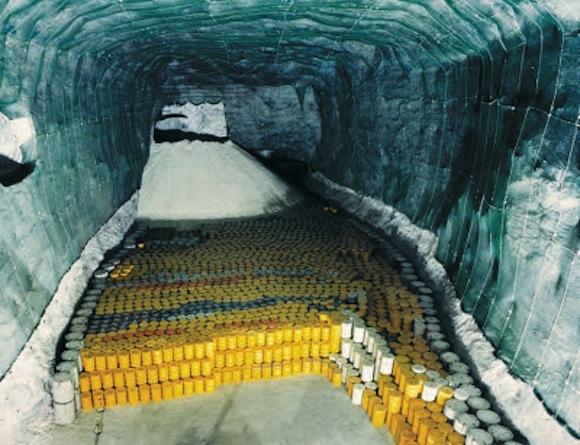
Japan’s 17,000 Tons of Nuclear Waste in Search of a Home - Bloomberg
July 9, 2015
by Yuriy Humber, Masumi Suga and Emi Urabe
Since atomic power was first harnessed more than 70 years ago, the industry has been trying to solve the problem of safe disposal of the waste. Japan has been thrown into the center of the conundrum by its decision in recent months to retire five reactors after the Fukushima disaster in 2011. It also decided this week to begin the restart process of one reactor despite public opposition.
“It’s part of the price of nuclear energy,” Allison Macfarlane, a former chief of the U.S. Nuclear Regulatory Commission, said in an interview in Tokyo on atomic waste. “Now, especially with the decommissioning of sites, there will be more pressure to do something with this material. Because you have to.”
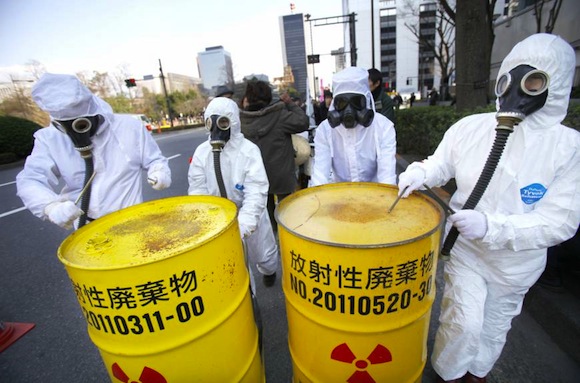
In the process, the world’s 437 operating reactors now produce about 12,000 tons of high-level waste a year, or the equivalent of 100 double-decker buses, according to the World Nuclear Association.
The U.S., with the most reactors, spent an estimated $15 billion on a site for nuclear refuse in Yucca Mountain, Nevada. Local opposition derailed the plan, meaning about 49,000 tons of spent fuel sits in cooling pools at nuclear plants around the country.
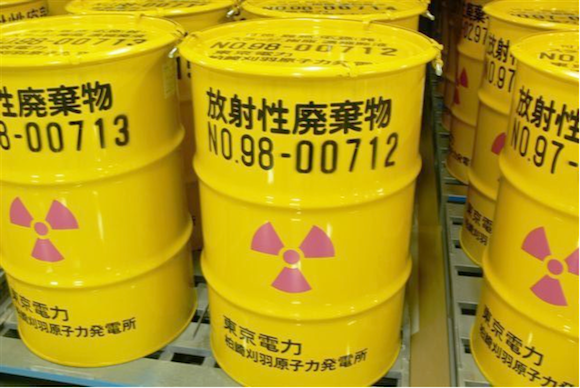
Wait just a sec here. If we recall correctly, there was over 70,000 tons and growing at a rate of about 10,000 tons a year about 5 years ago.
www.abovetopsecret.com...
From 2 September, 2012.
In a recent interview with The Real News Network, Robert Alvarez, a nuclear policy specialist since 1975, reports that spent nuclear fuel in the United States comprises the largest concentration of radioactivity on the planet: 71,000 metric tons.
Worse, since the Yucca Mountain waste repository has been scrapped due to its proximity to active faults, the US Nuclear Regulatory Commission has allowed reactor operators to store four times more waste in the spent fuel pools than they’re designed to handle.
Each Fukushima spent fuel pool holds about 100 metric tons, he says, while each US pool holds from 500-700 metric tons.
A single pool fire would release catastrophic amounts of radioactivity, rendering 17-22,000 square miles of area uninhabitable.
That’s about the size of New Hampshire and Vermont – from one pool fire.
World Nuclear Association
HLW is currently increasing by about 12,000 tonnes worldwide every year
It will need billions of dollars and technology not yet invented to clean up Fukushima. How long that will take is disputed. The operator, Tokyo Electric Power Co., estimates 40 years. Greenpeace says it could take twice that time.
So, it's really 80 plus years AFTER the technology is invented.
It will be a “failure in our ethical responsibility to future generations,” to restart reactors without a clear plan for waste storage, the Science Council of Japan said in April.
That's quite an understatement.
Japan’s Nuclear Waste Management Organization, known as NUMO, has been searching for a permanent storage site for years, initially inviting districts to apply as a host.
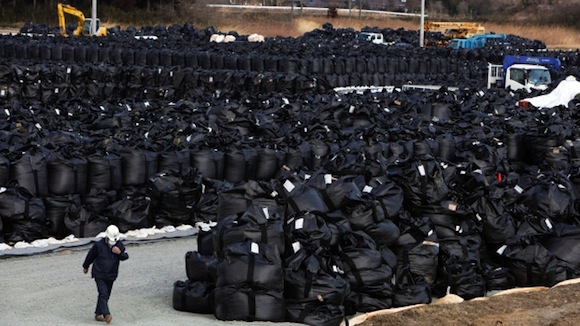
“We’d like all citizens to be aware and feel ownership of this situation,” said Takao Kino#a, a NUMO official. “We should feel grateful for the community that’s doing something for the benefit of the whole country and respect their bravery.”
What a bunch of malarky. Spreading the radioactive waste to parts of the country not yet radioactive (if that's possible) doesn't seem to be a good idea, IMHO, of course.
NUMO’s plan for a final underground repository was drawn up in 2007 and would cost 3.5 trillion yen ($29 billion).
It would contain about 40,000 canisters, each weighing half a ton and holding waste at temperatures above 200 degrees Celsius (392 Fahrenheit). The contents would give off 1,500 sieverts of radiation an hour, a level that would instantly kill a human being.
The canisters need to cool in interim storage for as long as 50 years before heading 300 meters below ground. Their stainless steel inner layer is wrapped in bentonite clay to make sure water can’t leak inside.
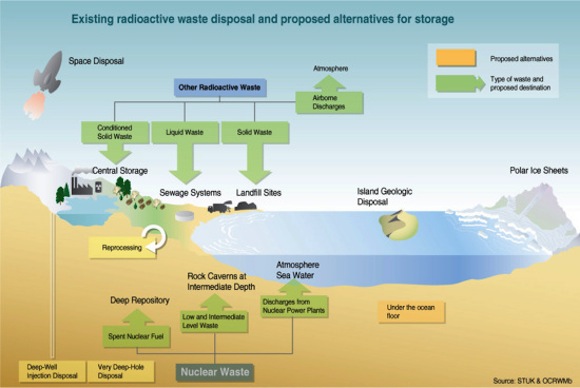
Japan’s government is responsible for dealing with the most radioactive waste. The plant operator handles the rest.
“Even in the low-level category there is the relatively higher-level waste and the nation’s technical solutions are not ready,” Makoto Yagi, the president of Kansai Electric Power Co., said at a June briefing in Tokyo.
Again with the "technology not yet invented to solve this life-threatening problem."
It seems implausible to continue down this waste conundrum road to hell without a solution to this 70 year old disaster in waiting.

a reply to: thorfourwinds
Good one TFW. A picture is worth a thousand words.
ON EDIT: By the way, when you look at the first picture, consider that the burial site is made of crystals (salt cavern) that hold on to the energy dispersed by the radiation turning that whole place into a huge bomb.
BOOOOOMMMMM.
Back to the drawing board.
Good one TFW. A picture is worth a thousand words.
ON EDIT: By the way, when you look at the first picture, consider that the burial site is made of crystals (salt cavern) that hold on to the energy dispersed by the radiation turning that whole place into a huge bomb.
BOOOOOMMMMM.
Back to the drawing board.
edit on 15-6-2016 by zworld because: (no reason given)
Oh my god will wonders never cease. TEPCO now admits there was a meltdown. And it only took 5 years. Boy, are they speedy or what.
fukushima-diary.com...
fukushima-diary.com...
And so it begins/continues… [sigh]
Turkey Point Update: Dead PhytoPlankton Locals Sick Miami a Nuclear Hot Mess - YouTube
Published on Apr 13, 2016
Turkey Point Update: Dead PhytoPlankton Locals Sick Miami a Nuclear Hot Mess - YouTube
Published on Apr 13, 2016
The plankton community and a key part of oceans, seas and freshwater basin ecosystems. Oxygen production: Phytoplankton absorb energy from the Sun and nutrients from the water to produce their own food. In the process of photosynthesis, phytoplankton release molecular oxygen (O2) into the water. It is estimated that between 50% — 85% of the world's oxygen is produced via phytoplankton photosynthesis.[15][16] The rest is produced via photosynthesis on land by plants.[16] Furthermore, phytoplankton photosynthesis has controlled the atmospheric CO2/O2 balance since the early Precambrian Eon.
Phytoplankton are photosynthesizing microscopic organisms that inhabit the upper sunlit layer of almost all oceans and bodies of fresh water. They are agents for "primary production," the creation of organic compounds from carbon dioxide dissolved in the water, a process that sustains the aquatic food web.[2] Phytoplankton obtain energy through the process of photosynthesis and must therefore live in the well-lit surface layer (termed the euphotic zone) of an ocean, sea, lake, or other body of water.
Phytoplankton account for half of all photosynthetic activity on Earth.[3][4] Their cumulative energy fixation in carbon compounds (primary production) is the basis for the vast majority of oceanic and also many freshwater food webs (chemosynthesis is a notable exception). The effects of anthropogenic warming on the global population of phytoplankton is an area of active research. Changes in the vertical stratification of the water column, the rate of temperature-dependent biological reactions, and the atmospheric supply of nutrients are expected to have important effects on future phytoplankton productivity.[5][6] Additionally, changes in the mortality of phytoplankton due to rates of zooplankton grazing may be significant. As a side note, one of the more remarkable food chains in the ocean – remarkable because of the small number of links – is that of phytoplankton-feeding krill (a crustacean similar to a tiny shrimp) feeding baleen whales.
And from the "yeah, this nuke stuff is great, let's build another one!!" department, the US just cranked up Watts Bar...
www.washingtonpost.com...
"SPRING CITY, Tenn. — In an immaculate control room at the Watts Bar nuclear plant, green bars flash on a large screen, signaling something that has not happened in the United States in two decades.
As control rods lift from the water in the core, and neutrons go about the business of splitting uranium atoms, life comes to a new nuclear reactor — the first in the country since its sister reactor here was licensed in 1996.
By summer’s end, authorities expect the new reactor at this complex along the Chickamauga Reservoir, a dammed section of the Tennessee River extending northward from Chattanooga, to steadily generate enough electricity to power 650,000 homes. Although the opening of a new nuclear facility used to draw protesters and angry rhetoric, the Tennessee Valley Authority’s Watts Bar reactor has been mostly welcomed by local residents — and even some advocates concerned about climate change.
“It’s a big step forward for clean energy, and we really have to be pushing that as hard as we can for the sake of the climate – all sources of clean energy, which includes nuclear,” said MIT atmospheric scientist Kerry Emanuel."
More at the link, but that's one more close enough to me to make sure I put a pin on the map.
BTW, here are the coordinates for the new plant.
Lat - 35°36'8.24"N
Long - 84°47'15.96"W
M
www.washingtonpost.com...
"SPRING CITY, Tenn. — In an immaculate control room at the Watts Bar nuclear plant, green bars flash on a large screen, signaling something that has not happened in the United States in two decades.
As control rods lift from the water in the core, and neutrons go about the business of splitting uranium atoms, life comes to a new nuclear reactor — the first in the country since its sister reactor here was licensed in 1996.
By summer’s end, authorities expect the new reactor at this complex along the Chickamauga Reservoir, a dammed section of the Tennessee River extending northward from Chattanooga, to steadily generate enough electricity to power 650,000 homes. Although the opening of a new nuclear facility used to draw protesters and angry rhetoric, the Tennessee Valley Authority’s Watts Bar reactor has been mostly welcomed by local residents — and even some advocates concerned about climate change.
“It’s a big step forward for clean energy, and we really have to be pushing that as hard as we can for the sake of the climate – all sources of clean energy, which includes nuclear,” said MIT atmospheric scientist Kerry Emanuel."
More at the link, but that's one more close enough to me to make sure I put a pin on the map.
BTW, here are the coordinates for the new plant.
Lat - 35°36'8.24"N
Long - 84°47'15.96"W
M
edit on 18-6-2016 by matadoor because: Add coordinates
Good news on US nukes from Wasserman. www.popularresistance.org...
5 More US Nukes To Close
A rising tsunami of U.S. nuke shut-downs may soon include California’s infamous Diablo Canyon double reactors. But it depends on citizen action, including a statewide petition (found at www.civilactionnetwork.org...)
Five U.S. reactor closures have been announced within the past month. A green regulatory decision on California’s environmental standards could push the number to seven.........
Because they can’t evenly compete with renewable energy or gas, a tsunami of shut-downs has swept away a dozen U.S. reactors since October, 2012. Dozens more teeter at the brink, including two at Indian Point, just north of Manhattan, and Ohio’s rapidly crumbling Davis-Besse reactor near Toledo.
5 More US Nukes To Close
A rising tsunami of U.S. nuke shut-downs may soon include California’s infamous Diablo Canyon double reactors. But it depends on citizen action, including a statewide petition (found at www.civilactionnetwork.org...)
Five U.S. reactor closures have been announced within the past month. A green regulatory decision on California’s environmental standards could push the number to seven.........
Because they can’t evenly compete with renewable energy or gas, a tsunami of shut-downs has swept away a dozen U.S. reactors since October, 2012. Dozens more teeter at the brink, including two at Indian Point, just north of Manhattan, and Ohio’s rapidly crumbling Davis-Besse reactor near Toledo.
Finally…
DPJ May Take Legal Action Against TEPCO For Meltdown Scandal | SimplyInfo
June 18th, 2016
DPJ May Take Legal Action Against TEPCO For Meltdown Scandal | SimplyInfo
June 18th, 2016
TEPCO’s “third party” investigation of their actions during the initial disaster has landed them in more trouble. The report insinuated that the Japanese government, specifically the Prime Minister’s office had told TEPCO to not disclose the meltdowns at Fukushima Daiichi.
This report did not interview any members of the Prime Minister’s cabinet that were involved with the disaster response. Now both former PM Kan and his cabinet secretary Yukio Edano have told the press that they did not instruct TEPCO to censor their language to the press about the disaster.
Okay ladies and gents, I need you to try really hard, and put on your SHOCKED face. Come on, really try it.
www.rt.com...
"TEPCO admits cover-up of Fukushima meltdown
The president of Japanese energy company TEPCO has confirmed the company covered up the meltdown of the Fukushima nuclear plant. The announcement came a week after a scandalous report claimed that Japanese government and TEPCO hushed up the tragedy.
The information was revealed by Tokyo Electric Power Co. President Naomi Hirose, who released an apology. He confirmed that TEPCO ordered not to use the word “meltdown” when referring to what happened at the crippled plant.
"I would say it was a cover-up," Hirose told a news conference. "It's extremely regrettable."
More at the link, okay, you can erase that shocked face now........
www.rt.com...
"TEPCO admits cover-up of Fukushima meltdown
The president of Japanese energy company TEPCO has confirmed the company covered up the meltdown of the Fukushima nuclear plant. The announcement came a week after a scandalous report claimed that Japanese government and TEPCO hushed up the tragedy.
The information was revealed by Tokyo Electric Power Co. President Naomi Hirose, who released an apology. He confirmed that TEPCO ordered not to use the word “meltdown” when referring to what happened at the crippled plant.
"I would say it was a cover-up," Hirose told a news conference. "It's extremely regrettable."
More at the link, okay, you can erase that shocked face now........
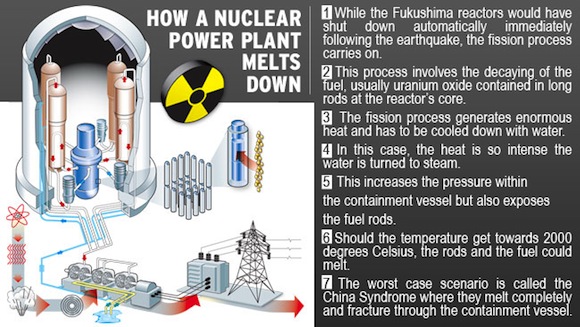
Tepco chief likely banned use of 'meltdown' under government pressure: report | The Japan Times
June 6, 2016
BY KAZUAKI NAGATA
The president of Tokyo Electric Power Co. during the Fukushima nuclear crisis told employees not to publicly use the term “meltdown,” apparently in response to government pressure, a third party report released Thursday said.
The report, compiled by three lawyers, said it is highly likely the government at the time pressured Masataka Shimizu, then Tepco’s president when the monstrous earthquake and tsunami disabled the Fukushima No. 1 nuclear power plant on March 11, 2011, about the utility’s disclosures in the early stages of the crisis.
The report said someone in the government, then headed by Prime Minister Naoto Kan of the Democratic Party of Japan, was unhappy Tepco had revealed a photo of the blown-up building for reactor No. 1 on March 12 without telling the government in advance.

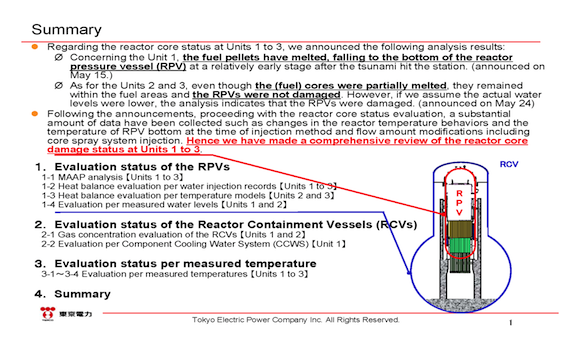
In February, nearly five years after the crisis, Tepco announced it should have declared the meltdowns earlier, citing the existence of a company manual that listed what constitutes a meltdown. The manual says that meltdown is a state in which 5 percent or more of the fuel rods is damaged.
As of March 14, 2011, Tepco estimated that 55 percent of the fuel rod assemblies in reactor No. 1 and 25 percent of those in reactor No. 3 were damaged but did not declare that they had melted until May that year.


So TEPCO is saying 75% of the fuel is still in the RPV?
Right . . .
OT: Hi all. Question. Has someone archived these two threads...somewhere? DDOS attacks seem a bit overwhelming I read. Bless all of you....And
especially that finding solutions continues.
backup is good. :')
I wish my mind was as good as so many of yours to add what you do.
Thank you.
backup is good. :')
I wish my mind was as good as so many of yours to add what you do.
Thank you.
TEPCO under fire after hiding massive radioactive waste leak at
Fukushima for a full year - NaturalNews.com

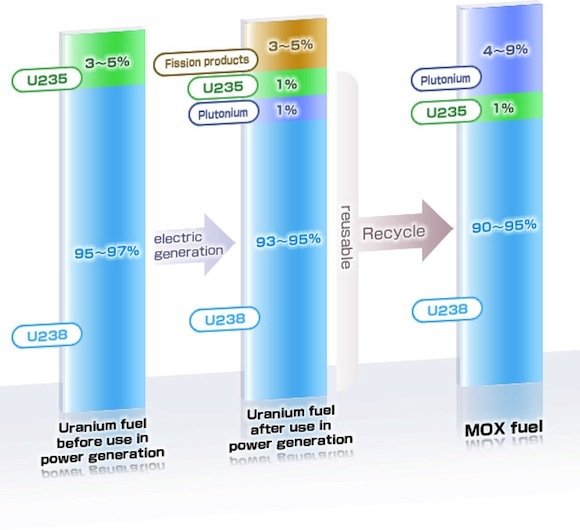
The major problem is that the plutonium in MOX is highly toxic in both the short and the long term.
Two comments appear beneath the article: “Incompetence at Japanese nuclear plants makes this a way bigger danger to humanity …”
The second was premonitory: "Maybe they forgot to tell everyone how they've determined there will never be any more earthquakes. Idiots are indeed correct. Likely long-term pain for short-term gain."


MOX, meaning "mixed oxides", is a highly dangerous and toxic fuel consisting of about 6-7% plutonium dioxide (obtained by re-treating used nuclear fuel) mixed with new depleted uranium dioxide. The fusion process starts more easily with MOX than with the usual fuels and it is used in 20 of the reactors in France.
The major problem is that the plutonium in MOX is highly toxic in both the short and the long term.
When suspended in air, it is estimated that a dose of about 10mg can cause the death of someone who has only once breathed in plutonium oxide. Evidence shows that even a tiny dose will trigger tumors in the lungs, and what’s worse, a significant part of what is breathed in passes through the lungs into the blood, which then carries it into other organs (lymph nodes, liver, etc), more or less quickly depending on the size of the particles, thus causing further cancers.
Because of its isotropic composition it is able to contaminate considerable volumes of sea water for a century, which is equivalent to its half-life in the best circumstances, and in the worst for 240 centuries!
The worst of it is that at 784 MW, reactor 3 is 1.5 times more powerful than reactor 1 at 460 MW, which is fueled with enriched uranium, thus its load of fuel, ie, plutonium, is much greater and the heat caused if it is stopped would be very much more intense and harder to manage.
a reply to: thorfourwinds
Greetings friend. I would bet most are still here, at least from time to time, reading, following along.
So a question...again, I'm full of them. Where is the Part I thread? Where? The largest thread on ATS, full of invaluable research, no longer available data, and a treasure trove of proof that then led to Part II? Where is it? My link is going to a dead end? Closed is one thing. Gone is something else entirely. Surely to God it is here...somewhere?#!?#&$!???
Part I has so much archived and needed in referencing back. Thanks for the information and help finding this. And thank you, all of you, for carrying on.
Peace and love
DWW
Greetings friend. I would bet most are still here, at least from time to time, reading, following along.
So a question...again, I'm full of them. Where is the Part I thread? Where? The largest thread on ATS, full of invaluable research, no longer available data, and a treasure trove of proof that then led to Part II? Where is it? My link is going to a dead end? Closed is one thing. Gone is something else entirely. Surely to God it is here...somewhere?#!?#&$!???
Part I has so much archived and needed in referencing back. Thanks for the information and help finding this. And thank you, all of you, for carrying on.
Peace and love
DWW
new topics
-
Watch as a 12 million years old Crab Emerges from a Rock
Ancient & Lost Civilizations: 2 hours ago -
ILLUMINATION: Dimensions / Degrees – Da Vincis Last Supper And The Philosophers Stone
Secret Societies: 8 hours ago -
Just Sick of It! Done! Can't take it anymore!
General Chit Chat: 9 hours ago -
Speaking of Pandemics
General Conspiracies: 11 hours ago -
Stuck Farmer And His Queue Jumping Spawn
Rant: 11 hours ago
top topics
-
Speaking of Pandemics
General Conspiracies: 11 hours ago, 9 flags -
Watch as a 12 million years old Crab Emerges from a Rock
Ancient & Lost Civilizations: 2 hours ago, 9 flags -
ILLUMINATION: Dimensions / Degrees – Da Vincis Last Supper And The Philosophers Stone
Secret Societies: 8 hours ago, 7 flags -
Just Sick of It! Done! Can't take it anymore!
General Chit Chat: 9 hours ago, 5 flags -
Stuck Farmer And His Queue Jumping Spawn
Rant: 11 hours ago, 4 flags
active topics
-
Matthew Livelsberger said he was being followed by FBI
Political Conspiracies • 72 • : WeMustCare -
Winter Storm
Fragile Earth • 30 • : RickinVa -
Candidate Harris Supporter MARK CUBAN Says Trump Has No Smart-Intelligent Women in His Orbit.
2024 Elections • 86 • : Oldcarpy2 -
Watch as a 12 million years old Crab Emerges from a Rock
Ancient & Lost Civilizations • 9 • : FullHeathen -
-@TH3WH17ERABB17- -Q- ---TIME TO SHOW THE WORLD--- -Part- --44--
Dissecting Disinformation • 3941 • : WeMustCare -
Orbs Appear And Form Triangle On Live Cam.
Aliens and UFOs • 28 • : DaydreamerX -
Musk calls on King Charles III to dissolve Parliament over Oldham sex grooming gangs
Mainstream News • 173 • : Oldcarpy2 -
Nigel Farage's New Year Message.
Politicians & People • 24 • : gortex -
Undiagnosed China Pneumonia Reported
Diseases and Pandemics • 48 • : AdultMaleHumanUK -
DONALD J. TRUMP - TIME's Most Extraordinary Person of the Year 2024.
Mainstream News • 60 • : xuenchen

